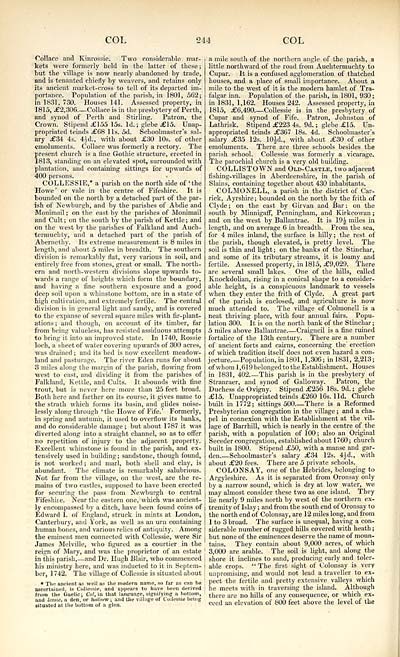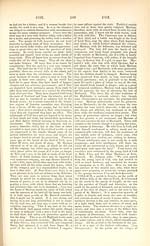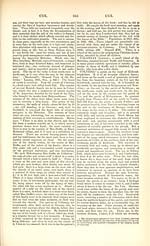Topographical, statistical, and historical gazetteer of Scotland > Volume 1
(324) Page 244 - COL
Download files
Complete book:
Individual page:
Thumbnail gallery: Grid view | List view

COL
244
COL
Collace and Kinrossie: Two considerable mar-
kets were formerly held in the latter of these ;
but the village is now nearly abandoned by trade,
and is tenanted chiefly by weavers, and retains only
its ancient market-cross to tell of its departed im-
portance. Population of the parish, in 1801, 562;
in 1831, 730. Houses 141. Assessed property, in
1815, £2,306. — Collace is in the presbytery of Perth,
and synod of Perth and Stirling. Patron, the
Crown. Stipend £155 15s. Id.; glebe £15. Unap-
propriated teinds £68 lis. 5d. Schoolmaster's sal-
ary £34 4s. Ui., with about £30 10s. of other
emoluments. Collace was formerly a rectory. The
present church is a fine Gothic structure, erected in
1813, standing on an elevated spot, surrounded with
plantation, and containing sittings for upwards of
400 persons.
COLLESSIE,* a parish on the north side of 'the
Howe' or vale in the centre of Fifeshire. It is
bounded on the north by a detached part of the par-
ish of Newburgh, and by the parishes of Abdie and
Monimail ; on the east by the parishes of Monimail
and Cult; on the south by the parish of Kettle; and
on the west by the parishes of Falkland and Auch-
termuchty, and a detached part of the parish of
Abernethy. Its extreme measurement is 8 miles in
length, and about 5 miles in breadth. The southern
division is remarkably flat, very various in soil, and
entirely free from stones, great or small. The north-
ern and north-western divisions slope upwards to-
wards a range of heights which form the boundary,
and having a fine southern exposure and a good
deep soil upon a whinstone bottom, are in a state of
high cultivation, and extremely fertile. The central
division is in general light and sandy, and is covered
to the expanse of several square miles with fir-plant-
ations ; and though, on account of its timber, far
from being valueless, has resisted assiduous attempts
to bring it into an improved state. In 1740, Rossie
loch, a sheet of water covering upwards of 300 acres,
was drained ; and its bed is now excellent meadow-
land and pasturage. The river Eden runs for about
3 miles along the margin of the parish, flowing from
west to east, and dividing it from the parishes of
Falkland, Kettle, and Cults. It abounds with fine
trout, but is never here more than 25 feet broad.
Both here and farther on its course, it gives name to
the strath which forms its basin, and glides noise-
lessly along through 'the Howe of Fife.' Formerly,
in spring and autumn, it used to overflow its banks,
and do considerable damage ; but about 1787 it was
diverted along into a straight channel, so as to offer
no repetition of injury to the adjacent property.
Excellent whinstone is found in the parish, and ex-
tensively used in building ; sandstone, though found,
is not worked ; and marl, both shell and clay, is
abundant. The climate is remarkably salubrious.
Not far from the village, on the west, are the re-
mains of two castles, supposed to have been erected
for securing the pass from Newburgh to central
Fifeshiie. Near the eastern one, which was ancient-
ly encompassed by a ditch, have been found coins of
Edward I. of England, struck in mints at London,
Canterbury, and York, as well as an urn containing
human bones, and various relics of antiquity. Among
the eminent men connected with Collessie, were Sir
James Melville, who figured as a courtier in the
reign of Mary, and was the proprietor of an estate
in this parish, — and Dr. Hugh Blair, who commenced
his ministry here, and was inducted to it in Septem-
ber, 1742. The village of Collessie is situated about
• The ancient as well as the modern name, so far as can be
ascertained, is Collessie, and appears to have been derived
from the Gaelic; Col, in that language, signifying a bottom,
and lassie, a den, or hollow ; and the village of Collessie being
situated at the bottom of a glen.
a mile south of the northern angle of the parish, a
little northward of the road from Auchtermuchty to
Cupar. It is a confused agglomeration of thatched
houses, and a place of small importance. About a
mile to the west of it is the modern hamlet of Tra-
falgar inn. Population of the parish, in 1801, 930;
in 1831, 1,162. Houses 242. Assessed property, in
1815, £6,490. — Collessie is in the presbytery of
Cupar and synod of Fife. Patron, Johnston of
Lathrisk. Stipend £223 4s. 9d. ; glebe £15. Un-
appropriated teinds £367 18s. 4d. Schoolmaster's
salary £35 12s. 10jd., with about £30 of other
emoluments. There are three schools besides the
parish school. Collessie was formerly a vicarage.
The parochial church is a very old building.
COLLISTOWN and Old-Castle, two adjacent
fishing-villages in Aberdeenshire, in the parish of
Slains, containing together about 430 inhabitants.
COLMONELL, a parish in the district of Car-
rick, Ayrshire ; bounded on the north by the frith of
Clyde ; on the east by Girvan and Bar : on the
south by Minnigaff, Penningham, and Kirkcowan ;
and on the west by Ballantrae. It is 19^ miles in
length, and on average 6 in breadth. From the sea,
for 4 miles inland, the surface is hilly ; the rest of
the parish, though elevated, is pretty level. The
soil is thin and fight; on the banks of the Stinchar,
and some of its tributary streams, it is loamy and
fertile. Assessed property, in 1815, £9,029. There
are several small lakes. One of the hills, called
Knockdolian, rising in a conical shape to a consider-
able height, is a conspicuous landmark to vessels
when they enter the frith of Clyde. A great part
of the parish is enclosed, and agriculture is now
much attended to. The village of Colmonell is a
neat thriving place, with four annual fairs. Popu-
lation 300. It is on the north bank of the Stinchar ;
5 miles above Ballantrae Craigneil is a fine ruined
fortalice of the 13th century. There are a number
of ancient forts and cairns, concerning the' erection
of which tradition itself does not even hazard a con-
jecture Population, in 1801, 1,306; in 1831, 2,213;
of whom l,619belongedtothe Establishment. Houses
in 1831, 402 This parish is in the presbytery of
Stranraer, and synod of Galloway. Patron, the
Duchess de Ovigny. Stipend £256 18s. 9d. ; glebe
£15. Unappropriated teinds £260 16s. lid. Church
built in 1772; sittings 500 There is a Reformed
Presbyterian congregation in the village ; and a cha-
pel in connexion with the Establishment at the vil-
lage of Barrhill, which is nearly in the centre of the
parish, with a population of 100; also an Original
Seceder congregation, established about 1760 ; church
built in 1800. Stipend £50, with a manse and gar-
den. — Schoolmaster's salary £34 12s. 4'd., with
about £20 fees. There are 5 private schools.
COLONSAY, one of the Hebrides, belonging to
Argyleshire. As it is separated from Oronsay only
by a narrow sound, which is dry at low water, we
may almost consider these two as one island. They
lie nearly 9 miles north by west of the northern ex-
tremity of Islay ; and from the south end of Oronsay to
the north end of Colonsay, are 12 miles long, and from
1 to 3 broad. The surface is unequal, having a con-
siderable number of rugged hills covered with heath ;
but none of the eminences deserve the name of moun-
tains. They contain about 9,000 acres, of which
3,000 are arable. The soil is light, and along the
shore it inclines to sand, producing early and toler-
able crops. " The first sight of Colonsay is very
unpromising, and would not lead a traveller to ex-
pect the fertile and pretty extensive valleys which
he meets with in traversing the island. Although
there are no hills of any consequence, or which ex-
ceed an elevation of 800 feet above the level of the
244
COL
Collace and Kinrossie: Two considerable mar-
kets were formerly held in the latter of these ;
but the village is now nearly abandoned by trade,
and is tenanted chiefly by weavers, and retains only
its ancient market-cross to tell of its departed im-
portance. Population of the parish, in 1801, 562;
in 1831, 730. Houses 141. Assessed property, in
1815, £2,306. — Collace is in the presbytery of Perth,
and synod of Perth and Stirling. Patron, the
Crown. Stipend £155 15s. Id.; glebe £15. Unap-
propriated teinds £68 lis. 5d. Schoolmaster's sal-
ary £34 4s. Ui., with about £30 10s. of other
emoluments. Collace was formerly a rectory. The
present church is a fine Gothic structure, erected in
1813, standing on an elevated spot, surrounded with
plantation, and containing sittings for upwards of
400 persons.
COLLESSIE,* a parish on the north side of 'the
Howe' or vale in the centre of Fifeshire. It is
bounded on the north by a detached part of the par-
ish of Newburgh, and by the parishes of Abdie and
Monimail ; on the east by the parishes of Monimail
and Cult; on the south by the parish of Kettle; and
on the west by the parishes of Falkland and Auch-
termuchty, and a detached part of the parish of
Abernethy. Its extreme measurement is 8 miles in
length, and about 5 miles in breadth. The southern
division is remarkably flat, very various in soil, and
entirely free from stones, great or small. The north-
ern and north-western divisions slope upwards to-
wards a range of heights which form the boundary,
and having a fine southern exposure and a good
deep soil upon a whinstone bottom, are in a state of
high cultivation, and extremely fertile. The central
division is in general light and sandy, and is covered
to the expanse of several square miles with fir-plant-
ations ; and though, on account of its timber, far
from being valueless, has resisted assiduous attempts
to bring it into an improved state. In 1740, Rossie
loch, a sheet of water covering upwards of 300 acres,
was drained ; and its bed is now excellent meadow-
land and pasturage. The river Eden runs for about
3 miles along the margin of the parish, flowing from
west to east, and dividing it from the parishes of
Falkland, Kettle, and Cults. It abounds with fine
trout, but is never here more than 25 feet broad.
Both here and farther on its course, it gives name to
the strath which forms its basin, and glides noise-
lessly along through 'the Howe of Fife.' Formerly,
in spring and autumn, it used to overflow its banks,
and do considerable damage ; but about 1787 it was
diverted along into a straight channel, so as to offer
no repetition of injury to the adjacent property.
Excellent whinstone is found in the parish, and ex-
tensively used in building ; sandstone, though found,
is not worked ; and marl, both shell and clay, is
abundant. The climate is remarkably salubrious.
Not far from the village, on the west, are the re-
mains of two castles, supposed to have been erected
for securing the pass from Newburgh to central
Fifeshiie. Near the eastern one, which was ancient-
ly encompassed by a ditch, have been found coins of
Edward I. of England, struck in mints at London,
Canterbury, and York, as well as an urn containing
human bones, and various relics of antiquity. Among
the eminent men connected with Collessie, were Sir
James Melville, who figured as a courtier in the
reign of Mary, and was the proprietor of an estate
in this parish, — and Dr. Hugh Blair, who commenced
his ministry here, and was inducted to it in Septem-
ber, 1742. The village of Collessie is situated about
• The ancient as well as the modern name, so far as can be
ascertained, is Collessie, and appears to have been derived
from the Gaelic; Col, in that language, signifying a bottom,
and lassie, a den, or hollow ; and the village of Collessie being
situated at the bottom of a glen.
a mile south of the northern angle of the parish, a
little northward of the road from Auchtermuchty to
Cupar. It is a confused agglomeration of thatched
houses, and a place of small importance. About a
mile to the west of it is the modern hamlet of Tra-
falgar inn. Population of the parish, in 1801, 930;
in 1831, 1,162. Houses 242. Assessed property, in
1815, £6,490. — Collessie is in the presbytery of
Cupar and synod of Fife. Patron, Johnston of
Lathrisk. Stipend £223 4s. 9d. ; glebe £15. Un-
appropriated teinds £367 18s. 4d. Schoolmaster's
salary £35 12s. 10jd., with about £30 of other
emoluments. There are three schools besides the
parish school. Collessie was formerly a vicarage.
The parochial church is a very old building.
COLLISTOWN and Old-Castle, two adjacent
fishing-villages in Aberdeenshire, in the parish of
Slains, containing together about 430 inhabitants.
COLMONELL, a parish in the district of Car-
rick, Ayrshire ; bounded on the north by the frith of
Clyde ; on the east by Girvan and Bar : on the
south by Minnigaff, Penningham, and Kirkcowan ;
and on the west by Ballantrae. It is 19^ miles in
length, and on average 6 in breadth. From the sea,
for 4 miles inland, the surface is hilly ; the rest of
the parish, though elevated, is pretty level. The
soil is thin and fight; on the banks of the Stinchar,
and some of its tributary streams, it is loamy and
fertile. Assessed property, in 1815, £9,029. There
are several small lakes. One of the hills, called
Knockdolian, rising in a conical shape to a consider-
able height, is a conspicuous landmark to vessels
when they enter the frith of Clyde. A great part
of the parish is enclosed, and agriculture is now
much attended to. The village of Colmonell is a
neat thriving place, with four annual fairs. Popu-
lation 300. It is on the north bank of the Stinchar ;
5 miles above Ballantrae Craigneil is a fine ruined
fortalice of the 13th century. There are a number
of ancient forts and cairns, concerning the' erection
of which tradition itself does not even hazard a con-
jecture Population, in 1801, 1,306; in 1831, 2,213;
of whom l,619belongedtothe Establishment. Houses
in 1831, 402 This parish is in the presbytery of
Stranraer, and synod of Galloway. Patron, the
Duchess de Ovigny. Stipend £256 18s. 9d. ; glebe
£15. Unappropriated teinds £260 16s. lid. Church
built in 1772; sittings 500 There is a Reformed
Presbyterian congregation in the village ; and a cha-
pel in connexion with the Establishment at the vil-
lage of Barrhill, which is nearly in the centre of the
parish, with a population of 100; also an Original
Seceder congregation, established about 1760 ; church
built in 1800. Stipend £50, with a manse and gar-
den. — Schoolmaster's salary £34 12s. 4'd., with
about £20 fees. There are 5 private schools.
COLONSAY, one of the Hebrides, belonging to
Argyleshire. As it is separated from Oronsay only
by a narrow sound, which is dry at low water, we
may almost consider these two as one island. They
lie nearly 9 miles north by west of the northern ex-
tremity of Islay ; and from the south end of Oronsay to
the north end of Colonsay, are 12 miles long, and from
1 to 3 broad. The surface is unequal, having a con-
siderable number of rugged hills covered with heath ;
but none of the eminences deserve the name of moun-
tains. They contain about 9,000 acres, of which
3,000 are arable. The soil is light, and along the
shore it inclines to sand, producing early and toler-
able crops. " The first sight of Colonsay is very
unpromising, and would not lead a traveller to ex-
pect the fertile and pretty extensive valleys which
he meets with in traversing the island. Although
there are no hills of any consequence, or which ex-
ceed an elevation of 800 feet above the level of the
Set display mode to: Large image | Transcription
Images and transcriptions on this page, including medium image downloads, may be used under the Creative Commons Attribution 4.0 International Licence unless otherwise stated. ![]()
| Gazetteers of Scotland, 1803-1901 > Topographical, statistical, and historical gazetteer of Scotland > Volume 1 > (324) Page 244 - COL |
|---|
| Permanent URL | https://digital.nls.uk/97441434 |
|---|
| Description | Volume first. A-H. |
|---|---|
| Attribution and copyright: |
|

